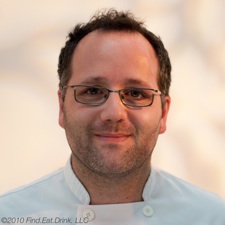Gastroarte Restaurant, formerly Graffit, Upper West Side, New York, Manhattan, Chef Jesus Nunez, Graffit, New York, NY, Spanish, Graffiti, Graffiti Artist, Molecular Gastronomy, Modern Spanish Cuisine, Where to eat, Chef Recommendations, Where to eat in Madrid, Barcelona, New York, Spain, Korea, Washington DC, Where to drink cocktails, favorite places to eat, Spanish Food
WHO
Chef and owner of the modern Spanish restaurant Gastroarte (formerly Graffit) on the Upper West Side of Manhattan.
WHY
Former graffiti artist turned chef brings his combination of modern Spanish cuisine and graffiti street art to create an interactive dining experience in New York.
RECOMMENDATIONS
Jesús Nuñez’s recommendations for where to eat and drink in New York, Washington DC, Madrid, Barcelona, and Korea.
Graffit is the New York restaurant debut of former graffiti artist-turned chef Jesús Nuñez, and his third restaurant overall. He previously owned two restaurants, Flou and Polenta in Madrid, Spain.
Taking the visual influence of street art and the sophistication of molecular gastronomy, chef Nuñez creates dishes that are visually bold, intellectually intriguing and layered with flavor. His playful approach to cooking brings out the inner child while satisfying the adult palate.
Q & A with chef Jesús Nuñez

Q. Please tell us about your new restaurant Gastroarte [Graffit]:
A. I’m very excited about Gastroarte (formerly Graffit). I want to bring modern Spanish cuisine to New York - the same food that put Spain on the world map as one of the capitals of modern cooking and gastronomy. I want to separate myself from the traditional Spanish restaurants that most Americans know, and open up their eyes to a Mediterranean cuisine that uses different techniques and ingredients to showcase the beautiful products that also hold a place in traditional cooking.
Gastroarte offers three menus - tapas, dinner and brunch - and each offers playful interpretations of traditional Spanish dishes and Mediterranean flavor combinations.
Q. What are some of your dishes that really explain your work?
A. I like to play with design with my dishes—with colors and textures. I also like to have fun with the client by surprising him or her, and bringing out the child that all of us have within.
There are a couple of recipes that truly exemplify my work. One is the “Cauliflower Egg.” In this recipe, I use a technique to create a false egg. Of course we also play with flavor. So I can have fun with the client by presenting him with a dish that looks like one thing but once tasted, turns out to be something completely different.
I also have a dessert on the opening menu that is “A Study of Moscatel,” in which I present Moscatel, a sweet Spanish wine, in different textures with various ingredients and flavor combinations that a sommelier would normally pair with a wine like Moscatel. It’s a very original dish because it allows the diner to eat the Moscatel with different textures and flavors.
Q. How do you incorporate the idea of graffiti into your food??
A. The years I spent as a graffiti artist help me combine colors and shapes on a plate. This is the part of graffiti that I use. Later on, I’ll introduce a dessert called “Graffiti” to my menu—but the actual dessert will be a surprise - all I’ll say is that we’ll let the client convert into a graffiti artist.
Q. How about in the design of your restaurant?
A. In the restaurant I wanted to take the most basic element of graffiti, which is spray paint on a brick wall, and soften it, make it more elegant and elevate to be something more than the typical street art. We were lucky enough to work with Chilean graffiti muralist Dasic Fernande, who painted Spanish images on the walls, like the beautiful Lola, our Flamenco dancer behind the bar, and Monolo the bullfighter and Vitorio the bull in the dining area.
Q. Your food has a bit of an experimental edge... how much trial and error goes into the dish before you find success?
A. It all depends on how complicated the recipe is. The more complicated, the greater the margin for error. I am a perfectionist, so when I decide to use a new technique, I have to work on the idea until I achieve the final result that I’m looking for. This can take hours, days or weeks.
Q. As a visual graffiti artist, what comes first when planning your dish... the look or the ingredients?
A. Again, it depends - sometimes I begin to work on a dish by starting with one ingredient that I know I want to use. Other times I’ll start with a color, or I’ll start with a plating idea that I want to express through the food. But I never forget about flavor, because in the end, that is the most important thing when eating a dish. I always say my goal is to have the client first eat with his or her eyes and then truly enjoy the dish with his/her mouth.
Q. When you were a graffiti artist, what were you tagging and were you doing it legally or as a tag and run?
A. My tag is Sir13, although really Sir13 is the name of my graffiti group. As to whether or not it was legal - 20 years ago, when I began painting, graffiti wasn’t a very well-understood art form. I would paint and run, although I also painted legally as well.
Advice / Tips

Q. For a cook that wants to deconstruct their dishes and serve something more unusual, can you lend any advice?
A. Well, for me, deconstruction is taking a recipe, analyzing the ingredients and deciding what would be the best way to manipulate the textures and rearrange the presentation, but still maintain the true flavor of the original dish, or recipe. This takes a lot of practice and my advice would be to start small with a simple dish that has a small number of ingredients, and build from there. Also be creative!
Q. Is there a recipe we can get you to share?
A. Sure, here is a quick and easy way to take a traditional Spanish dish, which is bread, tomato and Serrano ham, and turn it into a delicious appetizer. Get the recipe here.
Recommendations

FIND...
Q. What are some ingredients that you use that would really surprise us and how do you use them?
A. One of the more fun ingredients that I use are pop rocks - I love combining them with olive oil. Pop rocks really bring out all of the flavor notes of a high-quality extra virgin olive oil and make them explode in your mouth.
As far as other ingredients that may surprise you, given my Spanish background, I cook with every part of the pig - trotters, snout, face, tail, liver, cheeks - I could go on and on. The trotters are excellent when made into a stew with vegetables and white wine; the snout gets dredged in tempura batter and fried.
Q. Is there a gadget/tool that you love to use?
A. My favorite tool is a plating tong that my girlfriend bought me. It’s perfect for plating those little details that make a dish memorable.
My other favorite gadget is the Thermomix, which can’t be purchased here in the U.S., so I guess I’ll have to find a replacement.
[See details.]
Q. Is there a Spanish olive oil you can recommend and what do you love about it?
A. Boella Premium is an arbequina olive oil that has very delicate notes of apple and banana. You don’t need anything other than bread to enjoy it.
[See details.]
Q. Are there specific markets that you love?
A. Well, in Madrid I love the Mercado de San Miguel, which was renovated just one year ago. It’s an open-air market built under a metal structure, and there you can buy all types of products and also eat at the different bars inside.
In Barcelona, the Mercado de la Boqueria is magical. The colors, the environment, the variety of products make this market a really special place.
EAT...
Washington, DC
Q. Is there a restaurant in the United States serving authentic or great Spanish food?
A. Jaleo, José Andrés’ restaurant in Washington, D.C. I like that José Andrés tries to maintain the true essence of Spanish cuisine through his menu and preparations.
[See details.]
Spain
Q. What are the non-touristy restaurants we should go to in Madrid?
A. Diverxo: chef is David Muñoz. You should order the Menu Express+2, which is a tasting menu.
Zorzal: chef is Fernando Arellano. Order the Arroz de Conejo de Campo (Rice with Country Rabbit).
[See details.]
Q. Are there any traditional or iconic restaurants in Madrid that you would recommend?
A. The most traditional restaurant in Madrid is Zalacain. There you should order the menestra de verduras, which is a seasonal vegetable dish.
El Casino de Madrid is also a very classic upscale restaurant - Ferrán Adria used to be the consulting chef there.
Also, Las Cuevas de Luis Candelas is the perfect place to try cochinillo asado, or roasted baby pig.
[See details.]
Q. Are there places outside of Madrid?
A. In Barcelona, Alkimia. The chef Jordi Vilà is a friend of mine and the food is great.
[See details.]
New York
Q. What restaurants have you been excited by in New York?
A. I’m hard to please when it comes to dining out, although I really enjoy a few places here in NYC.
When I’m in the mood for something savory and full of umami flavor, I head to Fatty Crab. I really enjoy their Lo Si Fun pasta dish - it leaves a great umami taste in your mouth.
On the more upscale side, my girlfriend and I had the 8-course tasting menu at annisa about a month ago, and it was really wonderful - very flavorful and a creative mix of American and Asian flavors.
[See details.]
Q. Any great Spanish restaurants in New York?
A. As a Spanish person living in New York, I prefer to go to restaurants that don’t serve Spanish food... if I want the real thing, I’ll make it myself.
But I like Txikito - their Txipiron Encebollado, or squid ribbons, are very good.
Rayuela and Macondo on the Lower East Side are also very good Latin fusion restaurants and have great cocktails.
[See details.]
Korea
Q. You were Spain's culinary ambassador to Korea... do you have any great restaurant recommendations that you can pass along?
A. My opinion is that once you’re in Korea, you have to try the local street food and visit the market stands to truly understand the culinary culture and appreciate the ingredients.
However, if you’re looking for a more luxurious experience, there are a number of restaurants in the Hotel Lotte, including Pierre Gagnaire’s restaurant, that are worth the trip.
[See details.]
DRINK...
Q. Have you discovered a great place for a cocktail/wine/beer that you like in New York?
A. I’m not a big drinker and will usually only have a glass of wine or a beer when I go out. However, my girlfriend loves cocktails, and she’s always dragging me out to different places.
We like the Hurricane Club and the East Village tequila bar, Mayahuel.
[See details.]
Q. Where should we go in Madrid to start the night? End the night? And what to drink?
A. I like to start the night off at the Hotel Urban, where I usually order an apple martini - they’re excellent there.
Where do I finish the night? That really depends on the amount of energy I have. For a somewhat crazy night, I’ll usually end up in the Chocolatería San Miguel at 5 a.m. for hot chocolate and churros.
For a night that ends some time during the following day (Madrid style), I’ll end with beers and tapas in the Latina neighborhood of Madrid.
[See details.]
Q. What specific Spanish wines / beers / or beverages that you can recommend and what do you like about them?
A. As I said, I don’t drink much alcohol, but as far as wines, Ossian is an organic white wine from Rueda that I really like.
Also a nice, cold beer with lemon - a typical Spanish combination of draft beer and lemon Fanta - it is perfect on a hot day.
I sometimes finish off a big lunch or dinner with a green apple liquor.
And when I go out, I like to drink dark rum with orange Fanta.
[See details.]
Recommendations

Details of Jesús Nuñez’s recommendations for where to eat and drink in New York, Washington DC, Madrid, Barcelona, and Korea.
Food Recipes







Chef Jésus Nuñez
November 11, 2010





Gastroarte Restaurant (Formerly Graffit) - Upper West Side - New York, NY

Upper West Side
Modern Spanish
141 West 69th Street
New York, NY 10023 (view map)
T: 646.692.8762 (make a reservation)
Website:
Hours:
Mon - Fri: 4:30pm - 12am
Sat - Sun: 10am- 4pm; 5pm - 1am




























